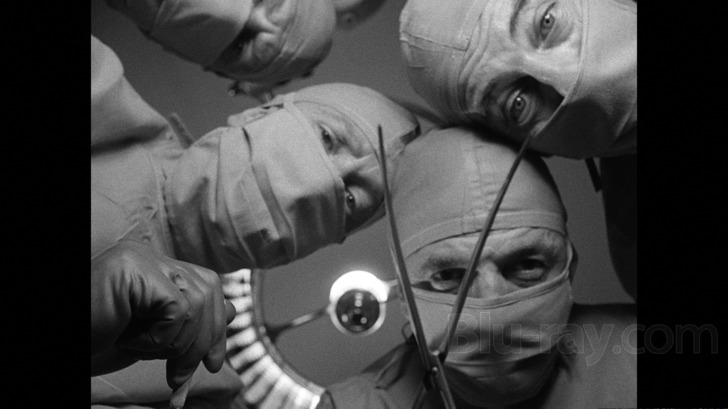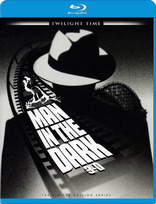Man in the Dark 3D Blu-ray Movie
HomeMan in the Dark 3D Blu-ray Movie 
Limited Edition - SOLD OUT / Blu-ray 3D + Blu-rayTwilight Time | 1953 | 67 min | Not rated | Jan 22, 2014
Movie rating
6.7 | / 10 |
Blu-ray rating
| Users | 4.0 | |
| Reviewer | 2.0 | |
| Overall | 3.1 |
Overview
Man in the Dark 3D (1953)
A thug is convicted and undergoes experimental brain surgery to remove criminal element in his brain. The operation wipes out all memory of his past life, including where he stashed the loot.
Starring: Edmond O'Brien, Audrey Totter, Ted de Corsia, Dan Riss, Horace McMahonDirector: Lew Landers
| Film-Noir | 100% |
| Crime | Insignificant |
| Drama | Insignificant |
| Thriller | Insignificant |
Specifications
Video
Video codec: MPEG-4 MVC
Video resolution: 1080p
Aspect ratio: 1.33:1
Original aspect ratio: 1.37:1
Audio
English: DTS-HD Master Audio Mono (48kHz, 24-bit)
Music: DTS-HD Master Audio 2.0 (48kHz, 24-bit)
Subtitles
English SDH
Discs
25GB Blu-ray Disc
Single disc (1 BD)
Blu-ray 3D
Playback
Region free
Review
Rating summary
| Movie | 2.0 | |
| Video | 4.5 | |
| Audio | 4.0 | |
| Extras | 0.5 | |
| Overall | 2.0 |
Man in the Dark 3D Blu-ray Movie Review
Reviewed by Jeffrey Kauffman January 20, 2014It’s pop quiz time: name the first major studio release of a 3D film (from the fifties' short lived 3D craze). Chances are, most people automatically think of the 1953 Vincent Price outing House of Wax 3D as the recipient of that particular honor, but the fact is a little remembered Columbia film called Man in the Dark actually beat House of Wax to the punch by a couple of days. (Film buffs will of course know that 1952’s Bwana Devil actually started the short-lived fifties 3D craze.) Some might argue that calling Columbia (at least the Columbia of the early fifties) a “major studio” might be stretching the truth just a bit, but while the studio was probably reeling a bit more from the decline in audiences than some of the other big production houses, it was nonetheless still churning out some sizable hits in those days, including iconic pictures like From Here to Eternity. Man in the Dark is nonetheless a pretty cheap looking (and feeling) film, running barely an hour and not exactly offering much in the way of drama or character, and instead relying on a veritable laundry list of “in your face” 3D shenanigans to create whatever inherent interest in the property there might be. The film’s advertising campaign, at least as evidenced by the trailer included on the Blu-ray (the only non-music supplement) and a cursory review of its posters, shows that Columbia was touting Man in the Dark as an exciting “thriller” jam packed with action and suspense. My personal hunch is most modern day viewers are going to find the film passable at best, a potboiler that oddly presages elements of Michael Crichton’s The Terminal Man while never really exploiting its central conceit— a hardened criminal who’s given an experimental brain operation to “cure” him of his antisocial tendencies—to any great degree. The film does have a few fun 3D effects, but those are hardly enough to warrant investing much time (let alone money to own) this lackluster offering.

Lobotomies hadn’t quite fallen out of favor when Man in the Dark came out in 1953, and there’s a none too subtle subtext that at least some of society’s ills can be cured by simply chopping out aberrant sections of any given individual’s brain. That’s the general gist of what’s about to happen to hardened criminal Steve Rawley (Edmond O’Brien), though as the film opens, it appears that Rawley is not all that eager to undergo the surgeon’s knife. In an amusing bit in the first scene, the tenor of the times is revealed when a cop brings Rawley cigarettes—hey, it’s not okay to have a criminal brain, but giving yourself cancer is just fine with everyone.
Rawley undergoes the operation, after raising a huge fuss—nearly getting in a fistfight in the process—after which a sedative makes him completely docile to the point where when the surgeon asks him to raise his knees in preparation for moving him to the operating table, there’s nary a peep. He emerges from the experimental surgery without any memory of his former identity or in fact of his previous criminal activities. He’s attended to by the kindly Dr. Marston (Dayton Lummis), who conveniently keeps track of his patient’s progress in a diary, where he’s especially helpful in pointing the way toward Rawley’s new identity by scratching his former name out and writing in “James Blake” in its place.
As Blake (and/or Rawley) continues his therapy by painting (painting?), Marston is meanwhile surprised by a visit from an insurance investigator named Jawald (Dan Riss), who informs the good doctor that Rawley had made off with a cool $130,000 (remember, this was 1953) that had never been found and that Jawald was intent on discovering its location. Marston of course informs him that Rawley is now Blake and has absolutely no memory of his former life. As if to put a period on the statement, the next scene shows Rawley working as the gardener at the hospital, replete with an enormous pair of shears. Unfortunately, Rawley’s previous gang members have somehow found out where he is and are waiting for him, and a rather confused Rawley, who of course insists he’s Blake, finds himself a confounded kidnap victim.
When he’s brought back to the bad guys’ lair, Rawley insists he knows nothing about the missing money, a refutation which continues even when he’s plied with kisses by his former girlfriend Peg (Audrey Totter, who spends much of the film looking like she’s passing an especially large kidney stone). Peg is disgusted when her amorous advances are met with stunned disbelief, and she storms off, leaving Rawley to face the music with his tougher gang mates. (Younger viewers may be confused by one moment where Rawley attempts to phone for help, running into the hazards of a “party line”.) The abbreviated third act of the film finds Rawley getting subliminal clues as to where he may have stashed the loot courtesy of some nightmares, while Peg starts to think that a life on the straight and narrow might be the better option for them in the long run.
Man in the Dark was rushed into production in order to take advantage of the then hot 3D phenomenon, and that rush means the film often plays like a “not quite ready for prime time” enterprise. The craft of the film is certainly serviceable, and the 3D effects actually quite good, but this is one lumbering, and at times completely illogical, movie. O’Brien is really the only “star” here (there are some fantastic character actors on board, make no mistake), but he simply doesn’t have the charisma to carry what is more or less a one man show, and he certainly doesn’t cut the mustard as a romantic lead, one reason why his scenes with Totter are almost laughable.
The film does have some nice location footage of Los Angeles in the early fifties, which may provide a certain nostalgia factor for some viewers, but this is one of the least thrilling putative “thrillers” ever made. The 3D effects may indeed add some much needed depth and dimensionality, but when you get right down to it, most of Man in the Dark is flatter than a veritable pancake.
Man in the Dark 3D Blu-ray Movie, Video Quality 

Man in the Dark is presented on Blu-ray with AVC (2D) and MVC (3D) encoded 1080p transfers in 1.33:1. This little
remembered film has been sourced from pristine elements and I personally have a hunch Columbia have had the original
camera negative available based on the results. (Even if that isn't the case, the film's brief length and relative lack of star
power probably meant it was not broadcast very much—I certainly don't remembering ever having seen it growing up—and
so even secondary elements could be in tip top condition.) Contrast is extremely strong, offering a nicely variegated array of
gray scale, whites and blacks. There are a couple of oddly soft shots—some of them at the amusement park later in the film
—but the bulk of this transfer looks sharp as a tack, with a completely intact layer of grain and no egregious signs of any
digital tampering.
The 3D experience is similarly excellent, yet another example of the old method having made the transition into
modern day efforts with surprising impact. Director Lew Landers exploits the medium throughout the film, with several "in
your face" shots (see screenshot 3 for a typical example). Some viewers may experience very minor crosstalk depending on
their setups in some of these shots where objects are thrust directly straight forward at the viewer, rather than being seen
from an angle. Otherwise, though, the 3D experience here is remarkably nuanced, with clear foreground differentiation and
a nice amount of depth into the frame.
Man in the Dark 3D Blu-ray Movie, Audio Quality 

Man in the Dark features a lossless DTS-HD Master Audio Mono track which is perfectly serviceable for a film that has few real sonic ambitions. Most of the film is simply dialogue driven, though there are a couple of good sequences where the soundtrack kicks up a notch, including the early chase after Rawley is abducted, and the final sequence in the amusement park. Fidelity is fine on this track, and there's no damage to report.
Man in the Dark 3D Blu-ray Movie, Special Features and Extras 

- Theatrical Trailer (1080p; 1:39)
- Isolated Score is presented in DTS-HD Master Audio 2.0.
Man in the Dark 3D Blu-ray Movie, Overall Score and Recommendation 

Man in the Dark may hold some historical value for discriminating cineastes, but when viewed objectively, the film really doesn't have a lot to offer. The plot is threadbare and at times completely illogical, the performers are decent journeymen but hardly the type anyone is going to "ooh" or "aah" over, and aside from the admittedly fun 3D effects, there's not much else to recommend this film. The fact that there are no mitigating factors like fantastic supplements here (even the isolated score is really nothing to write home about) makes this the very definition of a niche purchase. At least the technical merits are top notch, and those with a 3D home theater who are jonesin' for a new poke in the eye may get a kick out of this release.
Similar titles
Similar titles you might also like

Inferno 3D
Limited Edition to 3,000
1953

Dragonfly Squadron 3D
1954

High Sierra
1941

Gun Crazy
1950

The Chase
1946

Storm Fear
1955

On Dangerous Ground
Warner Archive Collection
1951

He Walked by Night
4K Restoration
1948

Highway Dragnet
1954

The Salton Sea
2002

Kiss Tomorrow Goodbye
1950

Straight Time
Warner Archive Collection
1978

Crashout
Gunmen on the Loose
1955

Hollow Triumph
The Scar
1948

He Ran All the Way
1951

White Heat
1949

99 River Street
1953

The Asphalt Jungle
1950

The Bubble 3D
1966

The Hitch-Hiker
1953
